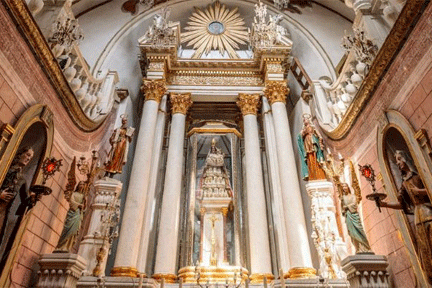The Chapel of Loreto
News Category: News and Community News
-
By Natalie Taylor
A few weeks ago I passed by the Chapel of Loreto and noticed that the gate was open. A man in a T-shirt and jeans was behind bars. I approached him and asked if I could talk to the father. “I am the father,” he said. I didn’t expect that, and when I told him about my research on art history at San Miguel and asked to see the chapel, he gladly agreed. When I returned a week later, Father Juan Francisco welcomed me inside. I had brought in photographer Jack Paulus and asked if it would be okay to take pictures. The father said yes.
We passed through the door that leads to the Chapel of Loreto, where I had never set foot. He took us to the real “holy house”, which is a replica of the house of the Virgin Mary in Nazareth. According to Church tradition, the archangels “saved her from destruction” by transporting her to Loreto, Italy. Hence the name, Virgin of Loreto. The Chapel of Loreto has the same dimensions as the original house, and under the altar are the remains of Manuel Tomás de La Canal and his wife María de Hervas. On one side, inside niches are large sculpted figures of each.
Inside the sacristy there are many paintings on the walls. There are paintings depicting all the archangels, St. Michael being the first and largest on canvas. The rest are all on rolled copper. On the opposite wall is a mural-size painting with signature and date: Andreas Lopez, 1795. Andreas López was an accomplished New Spanish painter who had studied with Miguel Cabrera, one of the most renowned painters of the colonial period. On a console along the wall with paintings of archangels, there are many objects, including a painting of the Virgin Mary that looks very Eastern Orthodox. Father Juan Francisco said she is the “virgin of Advent.” The other paintings along the sacristy depict all the famous conversions, including St. Egyptian Mary.
I asked about the Oratorians and Father explained that the order was originally founded by St. Philip Neri of Italy (1515-1595). But the congregation of the SMA Oratory was founded by Luis Felipe Neri de Alfaro, who came from Mexico City in the eighteenth century. In addition to founding the church in Atotonilco, Felipe Neri de Alfaro initiated several traditions that are still practiced at SMA to this day. One of them is the transport of the Lord of the Column every year, from Atotonilco to San Miguel de Allende. Father Juan Francisco said the canonization of Felipe Neri de Alfaro is “in process” and that sometimes the process can take centuries.
The chapel of Loreto was built by Manuel Tomás de la Canal in 1733. One hundred years later, in 1834, the remodeling included the construction of a dome by the architect Francisco Eduardo Tresguerras. The father showed us vestments, some of which are nearly 300 years old, elaborately decorated and still worn by priests to this day. Beyond the sacristy is another small room with an amazing tapestry covering the entire ceiling, resembling an intricate mosaic work. At the end of the room, there is a beautiful triple stained glass panel, made by a young man from San Miguel. It was commissioned two years ago on the occasion of the 400th anniversary of the canonization of St. Philip Neri (the Italian saint). In the same room, he pointed to a trapdoor in the floor that he said leads to a basement and lifted it up to show us. “The old priests say that it is part of the old tunnels of San Miguel,” he explained, and supposedly connect with the Allende Institute. I told him about another trapdoor in the Parish, which a young deacon showed me and said was part of the old tunnel system.
In the corridor (in front of the door leading to the Oratory), there was an oil painting high on the wall and it was quite difficult to see. With his tripod, Jack was able to zoom in and get a good view of the painting. The father was glad to see it through the lens, as he himself had never seen it up close. We complete our visit with views of some of the ancient treasures, under lock and key, including a golden chalice.
Natalie Taylor: BA in English Literature and Journalism, Loyola University, Chicago, 1995. Master of Fine Arts in Creative Writing, Vermont College, Montpelier, VT, 1999. Writer, editor and published journalist. Spanish teacher in the United States, English teacher in Buenos Aires, Argentina. Translator. www.natalietaylor.org Contact: tangonata@gmail.com
-


Leave a Reply